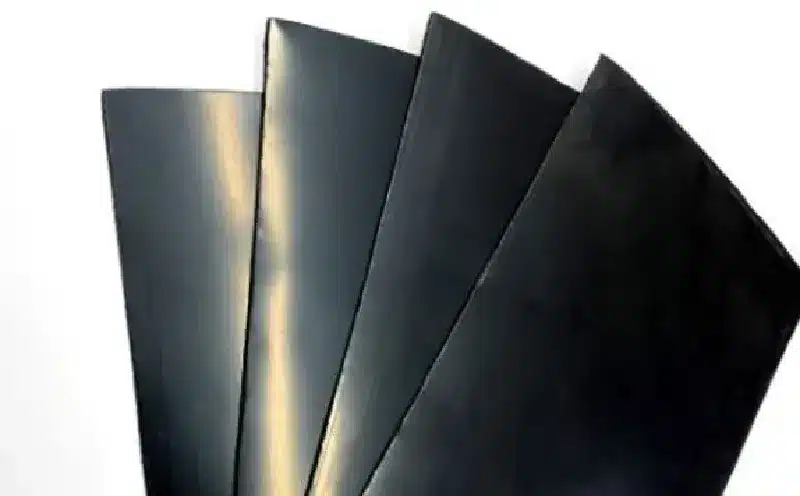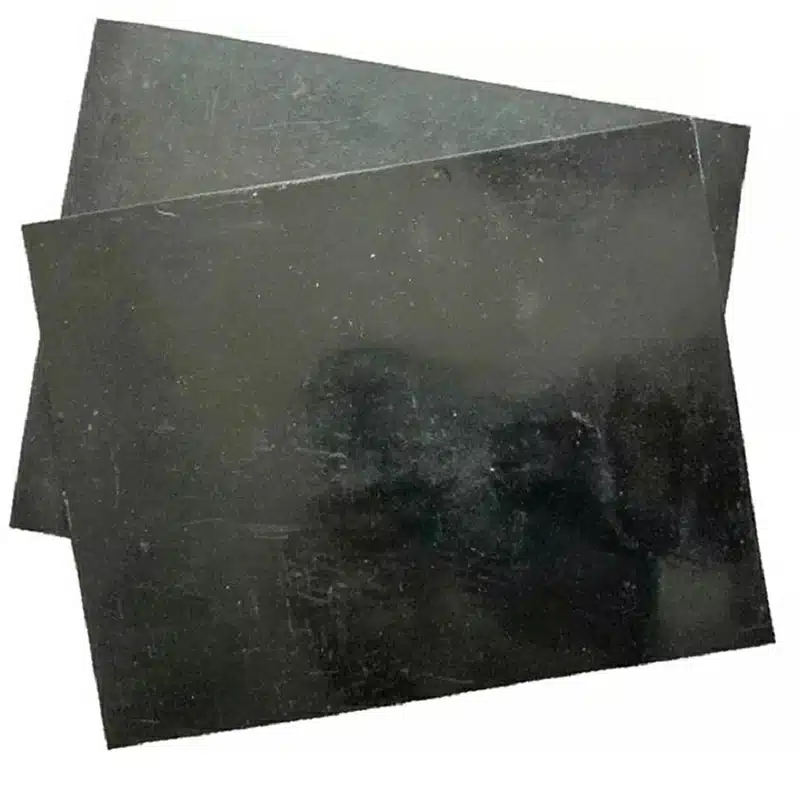+86-159 9860 6917
info@geofantex.com
geofantex@gmail.com
+86-400-8266163-44899
Geomembrane fabric is a fundamental component widely used in various environmental, geotechnical, and hydraulic applications. This article will provide a detailed insight into what geomembrane is, how it differs from geotextile, the raw materials used in its production, and its diverse applications. Understanding geomembrane helps professionals and stakeholders make informed decisions in projects requiring durable and effective containment solutions.
What is geomembrane material?
Definition of Geomembrane Material:
Geomembrane material is a type of synthetic membrane liner or barrier designed to control fluid movement in a man-made project, structure, or system. These membranes are used primarily in environmental, geotechnical, hydraulic, and transportation applications.
Composition:
Geomembranes are typically made from various polymers. The most common types include:
- High-Density Polyethylene (HDPE)
- Low-Density Polyethylene (LDPE)
- Linear Low-Density Polyethylene (LLDPE)
- Polyvinyl Chloride (PVC)
- Ethylene Propylene Diene Monomer (EPDM) rubber
- Polypropylene (PP)
Properties:
- Durability: Resistant to a wide range of chemicals and weather conditions.
- Flexibility: Can adapt to different surface contours and movements.
- Impermeability: Provides an effective barrier to liquids and gases.
- Strength: High tensile and puncture resistance.
- Longevity: Long-lasting performance, often exceeding several decades.
Uses:
Geomembranes are utilized in various applications, such as:
- Waste Management: Liners for landfills, hazardous waste, and sewage treatment plants.
- Water Containment: Ponds, reservoirs, canals, and aquaculture.
- Mining: Heap leach pads, tailings dams, and secondary containment.
- Construction: Waterproofing for foundations, tunnels, and roofs.
- Agriculture: Lining for irrigation channels, ponds, and silage pits.
Applications in Industries:
- Environmental Engineering: Used to protect soil and groundwater from contamination.
- Civil Engineering: Employed in infrastructure projects to manage water flow and prevent erosion.
- Mining Industry: Helps in the containment and processing of mining byproducts.
- Agriculture: Aids in efficient water management and storage.
Geomembranes are a critical component in modern engineering and environmental protection strategies, providing reliable solutions for fluid control and contamination prevention.

What is the difference between geotextile and geomembrane?
Geomembrane material is a type of synthetic membrane liner or barrier designed to control fluid movement in various applications. It is typically made from impermeable or semi-permeable materials, often polymers, to provide a high level of containment. Here are the key features and types of geomembrane materials:
Key Features:
- Impermeability: Prevents the passage of liquids and gases.
- Chemical Resistance: Withstands exposure to a variety of chemicals, making it suitable for waste containment.
- Durability: Long-lasting and can resist environmental stresses, UV radiation, and mechanical damage.
- Flexibility: Can conform to the shape of the ground or structure it covers.
- Ease of Installation: Lightweight and relatively easy to install.
Common Types of Geomembrane Materials:
- High-density polyethylene (HDPE): Known for its high strength-to-density ratio, chemical resistance, and UV stability. Commonly used in landfill liners, pond liners, and mining operations.
- Low-density polyethylene (LDPE): More flexible than HDPE, suitable for applications requiring adaptability to complex shapes.
- Linear Low-Density Polyethylene (LLDPE): Combines the strength of HDPE and the flexibility of LDPE. Often used in similar applications to HDPE and LDPE but provides a balance between strength and flexibility.
- Polyvinyl Chloride (PVC): Flexible and versatile, but less resistant to UV light and certain chemicals compared to polyethylene-based geomembranes. Used in potable water containment, decorative ponds, and some environmental applications.
- Ethylene Propylene Diene Monomer (EPDM): Extremely flexible and resistant to UV light and weathering. Commonly used in pond liners, water reservoirs, and roofing membranes.
- Chlorosulfonated Polyethylene (CSPE or Hypalon): Known for its exceptional chemical resistance, durability, and wearability. Used in applications with high exposure to harsh chemicals.
Applications:
- Environmental Protection: Used as liners for landfills, hazardous waste containment, and secondary containment systems.
- Water Management: Utilized in ponds, canals, reservoirs, and aquaculture to prevent water loss and contamination.
- Mining: Applied in heap leach pads, tailings storage facilities, and other containment systems to manage process fluids.
- Construction: Used as vapor barriers, roofing membranes, and under-slab barriers in building projects.
Geomembranes play a crucial role in modern civil and environmental engineering projects, providing reliable and cost-effective solutions for fluid containment and environmental protection.
What is the raw material for the geomembrane?
The raw material for geomembranes is typically a type of synthetic polymer. The most commonly used polymers for geomembranes include:
- High-Density Polyethylene (HDPE): Known for its high strength, chemical resistance, and UV resistance, HDPE is one of the most widely used materials for geomembranes.
- Linear Low-Density Polyethylene (LLDPE): Offers greater flexibility compared to HDPE while still providing good strength and chemical resistance.
- Polyvinyl Chloride (PVC): Known for its flexibility and ease of installation, PVC geomembranes are often used in applications requiring complex shapes and contours.
- Ethylene Propylene Diene Monomer (EPDM): A synthetic rubber with excellent flexibility, weatherability, and UV resistance, commonly used in pond liners and roofing membranes.
- Polypropylene (PP): Offers a balance between flexibility and strength, and is used in a variety of applications including landfills and water containment systems.
Each type of polymer has specific properties that make it suitable for different applications and environmental conditions. Additives such as UV stabilizers, plasticizers, and antioxidants are often incorporated to enhance performance characteristics.
What is geomembrane used for?
Geomembranes are impermeable membranes used for various purposes in several industries. Here is a structured explanation of their applications:
Environmental Protection
- Landfills: Geomembranes act as liners to prevent leachate from contaminating groundwater. They also serve as covers to prevent rainwater infiltration and gas escape.
- Mining: Used in heap leach pads and tailings ponds to prevent toxic chemicals from contaminating the environment.
Water Management
- Reservoirs and Ponds: Used to line reservoirs, ponds, and canals to prevent water seepage and loss.
- Wastewater Treatment: Employed in the lining of wastewater treatment plants to contain waste materials and prevent leakage.
Agriculture
- Irrigation Ponds: Used to line irrigation ponds, ensuring water availability during dry periods.
- Aquaculture: Used in fish and shrimp farming ponds to maintain water quality and prevent contamination.
Construction
- Foundations: Used as waterproofing layers in building foundations to prevent water ingress.
- Tunnels and Subways: Applied as liners in tunnels and subways to control groundwater seepage.
Energy
- Solar Ponds: Used to line solar ponds for the storage of thermal energy.
- Biogas Plants: Used as liners in biogas plants to contain organic waste and collect biogas.
Transport
- Roads and Railways: Used in the construction of roads and railways to prevent soil erosion and provide stability.
Other Industrial Uses
- Secondary Containment: Used in chemical plants for secondary containment to prevent spills and leaks.
- Floating Covers: Used in reservoirs to reduce water evaporation and contamination.
Geomembranes are vital in various sectors for their role in environmental protection, water conservation, and infrastructure development.
Geomembrane fabric is an indispensable material in modern engineering, offering effective solutions for waterproofing and containment challenges across diverse sectors. Its ability to isolate contaminants from the environment while withstanding harsh conditions makes it a go-to choice for engineers and project managers worldwide. With its distinct characteristics differentiated from geotextiles and its production from various synthetic materials, geomembrane continues to play a critical role in ensuring environmental protection and efficient resource management.



Get Free Sample
We’ll respond as soon as possible(within 12 hours)





















